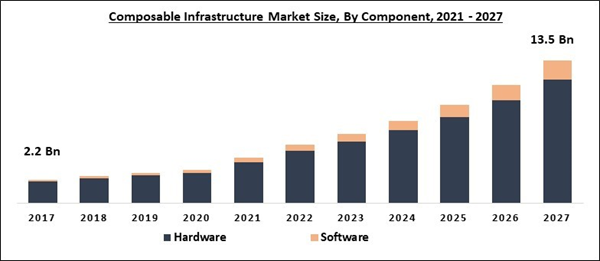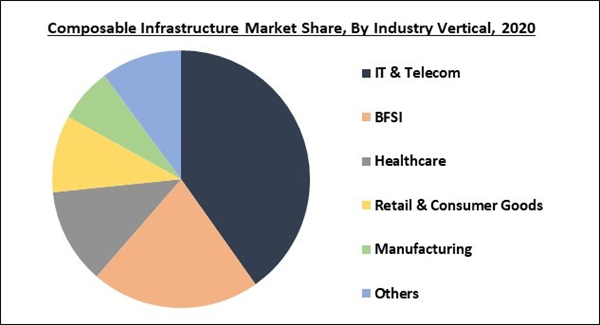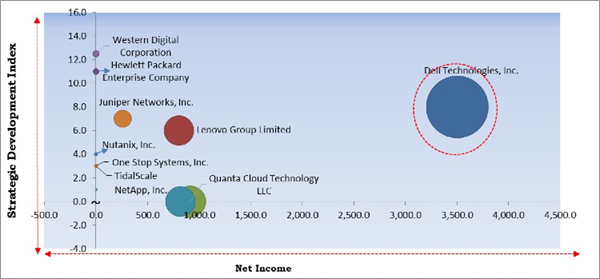The Global Composable Infrastructure Market size is expected to reach $13.5 billion by 2027, rising at a market growth of 21% CAGR during the forecast period. Composable infrastructure is considered as a framework that separates device resources in order to use them as services. A composable infrastructure is an approach to data center architecture that separates high-performance applications and workloads from the primary hardware. It allows the company’s data center to use their hardware devices, software solution-based infrastructure and helps in reducing the time needed for the adoption of any other application for the same processes. It also provides the value addition to the businesses and then delivers increased competencies in infrastructure operations. In addition, CI also reduces operation expenditure eliminating different administration tools that demand a high-level understanding and expertise.
In the present scenario, several companies are evolving their security management by adopting composable infrastructure to manage their data instead of using private data centers or on-premises solutions. Though, they are facing some challenges while adopting skilled IT professionals or experts and other IT solutions, which offer the same visibility and control on the place of on-premises solutions. Therefore, it is estimated that these factors will hamper the growth of the composable infrastructure market. Whereas, a significant increase in investments in data center technologies and the development of the hybrid cloud are offering lucrative opportunities for global market growth.
COVID-19 Impact Analysis
The outbreak of the COVID-19 pandemic has compelled the government of various nations like India, China, the UK, the US, and Germany to impose regulations to follow the covid guidelines properly and lockdown in these countries forced employees to work from home or remote locations. Employees have easy access to the data at remote locations through the public cloud. Hence, on-premise storage systems and public cloud storage helped employees by making their work synchronized and tasks easier. Many companies have realized that this working style is very beneficial and have decided to extend the duration of work from home, which is attributed to a surge in the demand for composable infrastructure.
During the pandemic, technology providers were pushing companies across all potential industries by offering modern composable infrastructure solutions. Companies were struggling to maintain continuity in their business and at that time adoption of composable infrastructure helped them to achieve significant growth in their businesses. For example, First Technology Incorporation came into a strategic alliance with Hewlett Packard Enterprise that allows businesses to improve their present IT infrastructure during this pandemic.
Market Growth Factors:
Provide efficiency and simplicity
In contrast with different and disconnected workflow-centric resources, the adoption of composable infrastructure offers a less complex environment in which a single infrastructure model is used across the organization. This helps in reducing the investment required for the staff training, a smaller number of silos of technical knowledge that mostly acts as a barrier in making changes, and providing a more open learning environment. In addition, composable infrastructure is a unique solution that supports constant IT service delivery.
The growing number of businesses are surging the demand for composable infrastructure
Various applications have come into existence due to changes made in the traditional applications. The latest applications are now demanding IT to be more responsive. With the help of a template-driven approach, composable infrastructure is able to reduce provisioning time and make infrastructure resources available whenever required. This allows infrastructure to act as a strategic asset instead of hampering the growing rate of business.
Market Restraining Factor:
Less number of skilled professionals and a lack of awareness
The adoption of composable infrastructure is not a very difficult task whereas its implementation is the major challenge which is faced by various organizations. Its implementation requires skilled professionals and advanced technologies & devices. In addition, the employees need to be trained before implementing composable infrastructure, which is increasing the investment of the company. Additionally, the low amount of awareness among the developing companies is hampering the growth of the composable infrastructure market.
Component Outlook
Based on Component, the market is segmented into Hardware and Software. The hardware segment acquired the highest revenue share in 2020. This segment comprises platforms and associated devices that are needed to improve IT infrastructure. The associated devices involve all on-premise systems like software licenses, database software, operating systems, racks, consoles, switches, keys, in-house data centers/servers, and other related hardware.
Industry Vertical Outlook
Based on Industry Vertical, the market is segmented into IT & Telecom, BFSI, Healthcare, Retail & Consumer Goods, Manufacturing and Others. The BFSI segment is anticipated to obtain the significant revenue share of the market during the forecasting period. The growth of the segment is augmented by the digital transformation. Financial institutions and banks generate and collect a huge volume of client’s data that is essential for the success of these institutes.
Regional Outlook
Based on Regions, the market is segmented into North America, Europe, Asia Pacific, and Latin America, Middle East & Africa. The Asia-Pacific composable infrastructure market is projected to witness the highest growth rate during the forecast period. The growing investment in smart city initiatives in the region is anticipated to augment the regional market growth. Further, the rapid increase in industrialization has led to the huge production of data, which is attributed to an increase in the demand for regional data storage management solutions.
Cardinal Matrix - Composable Infrastructure Market Competition Analysis
The major strategies followed by the market participants are Product Launches. Based on the Analysis presented in the Cardinal matrix; Dell Technologies, Inc. is the major forerunners in the Composable Infrastructure Market. Companies such as One Stop Systems, Inc., Quanta Cloud Technology LLC, TidalScale are some of the key innovators in the market.
The market research report covers the analysis of key stake holders of the market. Key companies profiled in the report include Hewlett Packard Enterprise Company, NetApp, Inc., Dell Technologies, Inc., Lenovo Group Limited, Nutanix, Inc., Juniper Networks, Inc., Western Digital Corporation, TidalScale, Quanta Cloud Technology LLC (Quanta Computer, Inc.) and One Stop Systems, Inc.
Recent Strategies Deployed in Composable Infrastructure Market
Partnerships, Collaborations, and Agreements:
- Jun-2021: Nutanix extended its partnership with Hewlett Packard Enterprise, an American multinational enterprise information technology company. This expansion aimed to boost hybrid cloud & multi-cloud adoption by providing Nutanix Era, which is a multi-database operation and management solution, combined with HPE ProLiant servers, as a service via HPE GreenLake. In addition, this fully managed cloud service is expected to enable users to implement applications and databases in minutes and get the advantage from the agile, elastic, and pay-per-use offerings of the cloud and also gaining the governance, visibility, and compliance of an on-premises surrounding.
- Nov-2020: Western Digital came into partnership with LINBIT, provider of a high-performing Software-Defined Storage (SDS) solution. Under this partnership, Western Digital’s OpenFlex platform is expected to integrate with LINBIT’s LINSTOR software, which is expected to enable northbound connectors to workload orchestrators such as Kubernetes (K8s) and OpenStack software. This partnership also aimed to enable LINBIT’s LINSTOR software support OpenFlex to operate in Kubernetes surroundings to support AI and other performance-hungry containerized applications.
- Aug-2020: Dell joined hands with Liqid, a software-defined composable infrastructure vendor. Under this collaboration, Dell is expected to add FPGAs, GPUs, and NVMe storage to the MX7000 composable system. This step made the MX7000 systems better suited for data-intensive applications like machine learning, AI, and low-latency analytics.
- Jul-2020: Hewlett Packard Enterprise (HPE) launched HPE GreenLake for Anthos. HPE partnered with Google in 2019 and now this launch is expected to be seen as the next step in their partnership. HPE GreenLake for Anthos enables customers to effortlessly build, operate, and manage services on-premises and in the cloud with the company's hybrid and multi-cloud platform.
Acquisitions and Mergers:
- Sep-2019: Western Digital took over Kazan Networks, a provider of NVMe (Non-Volatile Memory Express) over Fabrics. Through this acquisition, Western Digitaltook expanded its expertise in improved fabric-enabled architectures, which is expected to help the company to expand its portfolio of NVMe fabric-ready platforms and systems that include its OpenFlex composable disaggregated infrastructure (CDI) offerings.
- Nov-2018: Juniper Networks acquired HTBASE, a composable infrastructure firm. This acquisition aimed to bring multi-cloud storage to Juniper’s robust network and compute orchestration offerings of its Contrail Enterprise Multicloud.
- Feb-2017: Hewlett Packard Enterprise (HPE) took over SimpliVity, a leading provider of software-defined, hyperconverged infrastructure. This acquisition aimed to combine HPE and SimpliVity portfolio, which is expected to provide a rich set of enterprise data services over 3PAR storage, hyperconverged, composable infrastructure, and multi-cloud offerings.
Product Launches and Product Expansions:
- Aug-2021: Juniper Networks introduced the latest workload platform to connect and safeguard applications against malicious activities in real-time under zero-trust data center architecture. The Cloud Workload Protection platform enables a safety net for applications and their workloads. In addition, the platform also offers signatureless run-time application self-protection (RASP), vulnerability detection, memory-based attack prevention, optimized control-flow integrity (OCFI) technology, comprehensive telemetry, and zero-trust micro segmentation.
- Sep-2020: Lenovo, together with Microsoft, Nutanix, and VMware, unveiled a variety of new and updated ThinkAgile hyperconverged infrastructure (HCI) appliances and systems. This range enables users to get comfortable with the new normal that is remote work.
- May-2020: Dell released PowerStore, the much-anticipated storage array line. PowerStore is developed for a data-centric era with storage required for virtual, physical, and containerised workloads.
- Nov-2019: Hewlett Packard Enterprise (HPE) introduced integrated intelligence and composability offerings. These offerings are the combination of artificial intelligence (AI) and machine learning-driven HPE Primera storage platform with the composability in HPE Synergy and HPE Composable Rack1, which helps users to swiftly offer the latest apps and innovations to expand their businesses.
- Aug-2019: Western Digital launched the Ultrastar DC SN640 and Ultrastar DC SN340, two new 96-layer 3D flash NVMe SSD families. These two products are specially built for either mixed-use-case workloads or very read-intensive applications, respectively. The latest Ultrastar drives aid in fulfilling the evolving, and highly specific workload demands placed on data centers and also laying a strong, flexible foundation for the zettabyte-scale era of the future.
- Aug-2018: Western Digital unveiled its latest OpenFlex storage architecture and the first portfolio of products supporting it. This OpenFlex architecture aims to help operators of data centers separately scale compute, storage, and network resources by utilizing software composable infrastructure (SCI).
- Aug-2018: Dell introduced PowerEdge MX, its composable infrastructure system. This system is developed to flexibly support both conventional and evolving workloads like artificial intelligence, IoT, and machine learning while streamlining and consolidating IT management.
Scope of the Study
Market Segments Covered in the Report:
By Component
- Hardware
- Software
By Industry Vertical
- IT & Telecom
- BFSI
- Healthcare
- Retail & Consumer Goods
- Manufacturing
- Others
By Geography
- North America
- US
- Canada
- Mexico
- Rest of North America
- Europe
- Germany
- UK
- France
- Russia
- Spain
- Italy
- Rest of Europe
- Asia Pacific
- China
- Japan
- India
- South Korea
- Singapore
- Malaysia
- Rest of Asia Pacific
- LAMEA
- Brazil
- Argentina
- UAE
- Saudi Arabia
- South Africa
- Nigeria
- Rest of LAMEA
Key Market Players
List of Companies Profiled in the Report:
- Hewlett Packard Enterprise Company
- NetApp, Inc.
- Dell Technologies, Inc.
- Lenovo Group Limited
- Nutanix, Inc.
- Juniper Networks, Inc.
- Western Digital Corporation
- TidalScale
- Quanta Cloud Technology LLC (Quanta Computer, Inc.)
- One Stop Systems, Inc.
Unique Offerings from the Publisher
- Exhaustive coverage
- The highest number of market tables and figures
- Subscription-based model available
- Guaranteed best price
- Assured post sales research support with 10% customization free
Table of Contents
Companies Mentioned
- Hewlett Packard Enterprise Company
- NetApp, Inc.
- Dell Technologies, Inc.
- Lenovo Group Limited
- Nutanix, Inc.
- Juniper Networks, Inc.
- Western Digital Corporation
- TidalScale
- Quanta Cloud Technology LLC (Quanta Computer, Inc.)
- One Stop Systems, Inc.
Methodology

LOADING...











